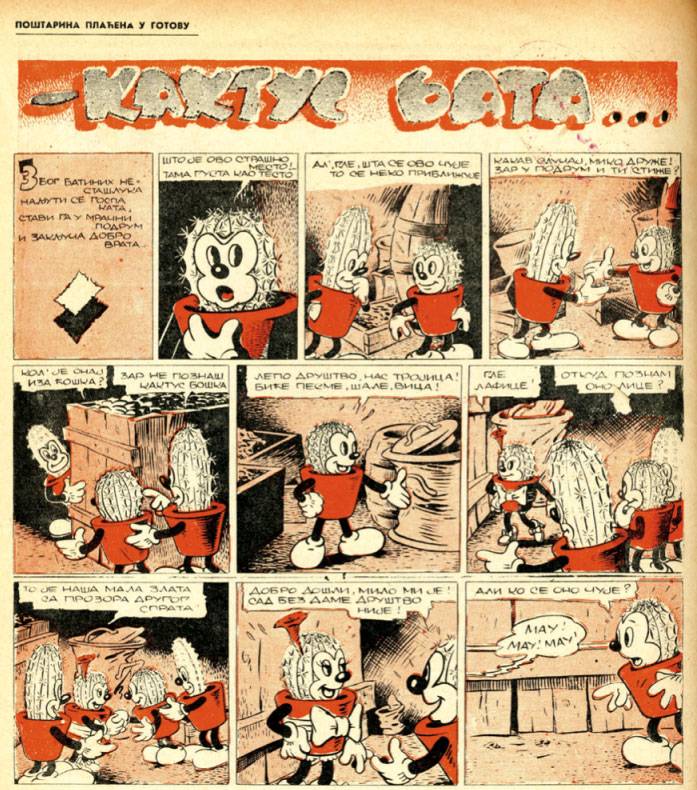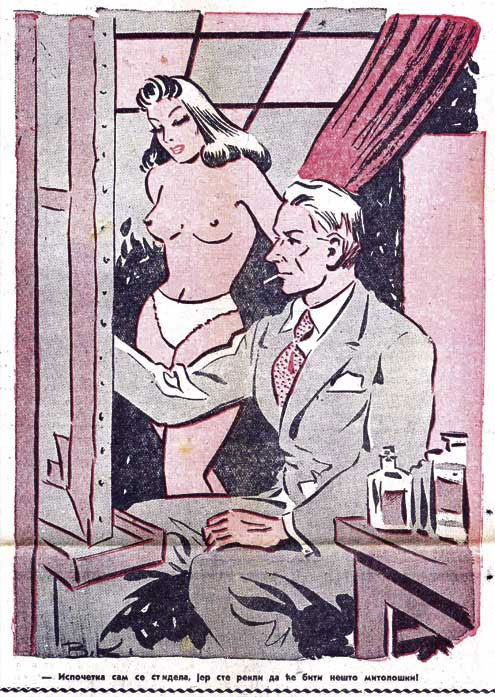Veljko Kockar was a mid-20th century Croatian comic artist, active between 1938 and 1944. He drew realistic comics, but also a cartoony series like his signature work 'Kaktus Bata' (1941). His career was cut short at age 24, when he was executed near the end of World War II by partisan forces. Yet he was an important pioneer in Yugoslavian comics, and Croatian comics in particular.
Early life and career
Not much is known about Veljko Kockar's life. He was born in 1920 in Osijek, Yugoslavia (nowadays located in Croatia). According to his sister, he already enjoyed drawing from a young age. Judging the kind of comics he drew as an adult, his main graphic influences were the Americans Floyd Gottfredson, Alex Raymond and Hal Foster. Between September 1935 and late 1938, Kockar went to school in Belgrade. It is unknown whether he ever went to an art academy.
Early comics
At age 18, in 1938, Veljko Kockar became a contributor to the comics weekly Paja Patak (the Croatian name of Donald Duck). Paja Patak, established on 2 October 1938, was despite its name and the publication of Disney comics, not purely a Disney comic magazine. Most of its content was created by Yugoslavian artists like Marijan Ebner, Dragan Kalmarevic, Sebastijan Lechner and Zika Mitrovic. Kockar provided cover illustrations, but also his first comic strip: 'Osveta kraljice Tao-Maj' ("The Revenge of Queen Tao-May"), a realistically drawn adventure serial in the style of Alex Raymond and Hal Foster. Paper shortage prevented him from finishing the story. By 1939, Paja Patak already ceased publication because it couldn't compete with the far more popular Disney comic magazine Mika Miš.
World War II
From the time period between 1939 and October 1941, when World War II took most of Europe by storm, Kockar's activities are unknown. Although Yugoslavia managed to keep out of the conflict for a couple of years, the country still went through much political turmoil. On 27 March 1941, the Allied Forces backed up a military coup which forced regent Prince Paul into abdication and brought his cousin Peter II to the throne. While Prince Paul was indecisive about the threat of the Axis Powers, Peter II was far more outspoken in his support for the Allied Forces. As a result, only a month later, Hitler and Mussolini occupied Yugoslavia and Greece. Peter II and his government fled, while Yugoslavia was split up into two puppet states, the Serbian "Government of National Salvation" and the "Independent State of Croatia".
Kaktus Bata
In October 1941, Kockar became a cartoonist for the Nazi-controlled magazine Dom I Sviet ("Home and World"). There, he introduced his best-known comic creation, 'Kaktus Bata' ("Bata the Cactus", 1941), about a cactus in a flower pot coming to life. His adventures show clear influence from Floyd Gottfredsson's 'Mickey Mouse' comics. Not only in Bata's design, but also in the overall drawings and narratives. However, Dom I Sviet didn't last long either. In January 1942, it was replaced by another magazine, Kolo.
Other mid-1940s work
In the second half of 1942, Kockar's art also appeared in the comic magazine Strip Knjizi. He drew two fairy tale stories, 'Čarobni prsten' ("Magic Fingers") and 'Zlatan cvet' ("The Zlatan Flower"), as well as the adventures of the comic duo 'Raja I Gaja' ("Raja and Gaja"). In 1943, he launched two other series, 'Dr Pjer' ("Dr. Pierre", scripted by Dragan Savić) and 'Kopači Zlata' ("The Gold Diggers"). In addition, Kockar drew gag panels featuring sexy girls, which appeared in the magazine Bodljkavo Prase ("Prickly Pig").
Death
World War II seriously hindered Kockar's career. Paper shortage ensured that many of the papers he appeared in usually didn't last longer than a couple of months. But the Nazis were also losing the war. On 20 October 1944, Belgrade was liberated by the Yugoslav Partisan Army, supported by the Russian Red Army. Although the rest of Yugoslavia was still occupied, this was nevertheless a significant victory for the Resistance. Both Nazis and local citizens who had supported the occupiers were now arrested or killed. Kockar was arrested too. An article published in Politika on 27 November 1944 described him as a "student in technics, Gestapo agent and notable for spreading lies and slander about the resistance movement." He was executed the same day, without trial. Kockar was only 24 years old.
Tragically enough, Veljko Kockar was actually the victim of vicious slander and post-war thirst for revenge. Comic historian Zdravko Zupan checked the city archives of Belgrado to scrutinize their list of Gestapo collaborators, but couldn't find Kockar's name. The cartoonist was likely only executed because he had published in Nazi propaganda newspapers. Zupan studied all of Kockar's war-time comics and came to the conclusion that they were all escapist, apolitical children's stories. None featured any anti-Semitic or pro-Nazi content. In hindsight, Kockar probably had the bad luck of being among the first people arrested and executed for Nazi collaboration. If he had been arrested a couple of months later, especially after the war, it is likely that he would have received a more fair trial and perhaps only a jail sentence. In 1945, his cartoonist colleague Marijan Ebner mysteriously disappeared as well, presumably undergoing the same fate as Veljko Kockar.
Legacy
Veljko Kockar remains a mysterious person. He was never photographed, let alone interviewed, so large parts of his personal history remain vague. The false collaboration accusations tainted his name. Since he mostly published in obscure, short-lived comic magazines he would have likely faded away in obscurity if comic historian Zdravko Zupan hadn't begun his thorough research. He originally assumed that Kockar's name was a pseudonym for the cartoonist Dragan Kalmarević. Only after Zupan interviewed one of Kockar's former colleagues, Radomir Perica, he found out that Kockar was a real person. Zupan talked with cartoonist Milorad Dobrić, who said he once heard a man brag about how he executed Kockar. Dobrić was so shocked that he could only curse. Zupan's research was continued by Sasa Rakezic, who managed to track down Veljko Kockar's older sister Jovanka and one of Kockar's schoolmates Emil Šuh.
Books about Veljko Kockar
Thanks to the efforts of comic historian Zdravko Zupan and publisher Aleksandar Zograf, Kockar's comics were collected and reprinted in 2009. From his first story ('Osveta kraljice Tao-Maj') until his last, unfinished comic 'Kopača Zlata'. They also did thorough research to find out more about this life and career, enough to present a full biography/monograph: 'Veljko Kockar - Strip, život, smrt' ("Veljko Kockar - Comics, Life, Death", Pancevo, 2009). In 2018, George Markovic also directed a documentary titled 'Poslednja avantura Kaktusa Bate' ("The Final Adventure of Bata the Cactus"), which not only dealt with Kockar's life and career, but also the Yugoslav comics scene during World War II.
Self-portrait (presumably) by Veljko Kockar.





